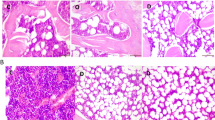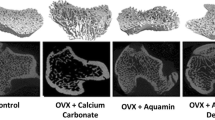Abstract
The aim of this study was to investigate the effect of heparin on osteoporosis initiation, and the effect of selenium plus vitamins E and C, and the sole combination of vitamins E and C on the progress of osteoporosis induced by heparin through histologic means. Adult female New Zealand white rabbits were divided into three experimental and three control groups. The experimental rabbits were injected with 1000 IU/kg/day heparin (Liquemine) for 4 weeks. These six groups were administered deionized water (CI and EI), 100 mg/kg/day l-ascorbic acid plus 100 mg/kg/day α-tocopherol acetate (CII and EII), and 0.05 mg/kg/day sodium selenite, plus these vitamins orally, with a gastric catheter (CIII and EIII), respectively. At the end of the experimental period, the femurs of the animals were collected and investigated under a light photomicroscope. Heparin caused important alterations in bone, such as an improper lamellar structure and a large uncalcified bone matrix. These findings implied the early phase of osteoporosis induced by heparin use. The combination of vitamins E and C given to the experimental rabbits partially prevented this bone tissue destruction. When sodium selenite was given together with vitamins E and C to the osteoporosis model rabbits, the long bone tissue had almost the same structure as in normal rabbits, for example the development of numerous bone trabeculae. Our results suggest that a combination of sodium selenite with vitamins E and C was more effective than combinations of single vitamins to prevent structural alterations in these model bones.


Similar content being viewed by others
References
Burk RF (1983) Biological activity of selenium. Ann Rev Nutr 3:53–70
Sokoloff L (1985) Endemic forms of osteoarthritis. Clin Rheum Dis 11:187–212
Yang C, Niu C, Bodo M et al. (1993) Fulvic acid supplementation and selenium deficiency disturb the structure and integrity of mouse skeletal tissue. J Biochem 289:829–835
Sasaki S, Iwata H, Ishiguro N, Habuchi O, Miura T (1994) Low-selenium diet, bone and articular cartilage in rats. Nutrition 10:538–543
Moreno-Reyes R, Egrise D, Neve J, Pasteels JL, Schoutens A (2001) Selenium deficiency-induced growth retardation is associated with an impaired bone metabolism and osteopenia. J Bone Miner Res 16:1556–1563
Hurt HD, Carry EE, Visek WJ (1971) Growth, reproduction, and tissue concentrations of selenium in the selenium-depleted rat. J Nutr 101:761–766
Tsukahara H, Deguchi Y, Miura M et al. (1996) Selenium status and skeletal tissue metabolism in young infants. Eur J Pediatr 155:148–149
Levander OA, Burk RF (1994) Selenium. In: Shils ME, Olson JA, Shike M, eds. Modern nutrition in health and disease. Philadelphia, Lea & Febiger, 242–251
Apostolski S, Marinkovic Z, Nikolic A, Blagojevic D, SpasicMB, Michelson AM (1998) Glutathione peroxidase in amyotrophic lateral sclerosis. The effects of selenium supplementation. J Environ Pathol Toxicol Oncol 17:325–329
Chan S, Gerson B, Subramainan S (1998) The role of copper, molybdenum, selenium and zinc in nutrition and health. Clin Lab Med 18:673–685
Schwarz K, Foltz CM (1957) Selenium as an integral part of factor 3 against dietary necrotic liver degeneration. J Am Chem Soc 79:3292–3293
Bartfay WJ, Hou D, Brittenham GM et al. (1998) The synergistic effects of vitamin E and selenium in iron-overloaded mouse hearts. Can J Cardiol 14:937–941
Schwenke DC, Behr SR (1998) Vitamin E combined with selenium inhibits atherosclerosis in hypercholesterolemic rabbits independentlyof effects on plasma cholesterol concentrations. Circ Res 83:366–377
Mahfouz MM, Kawano H, Kummerow FA (1997) Effect of cholesterol-rich diets with an without added vitamins E and C on the severity of atherosclerosis in rabbits. Am J Clin Nutr 66:1240–1249
Matzsch T,Bergquist D, Hedner U, Nilsson B, Ostergaard P (1986) Heparin-induced orteoporosis in rat. Thrombosis and Haemostasis 56:293–294
Matzsch T,Bergquist D, Hedner U, Nilsson B, Ostergaard P (1990) Effects of low molecular heparin and unfragmented heparin on induction of osteoporosis in rats. Thromb Haemost 63:505–509
Ginsberg JS, Kowalchuk G, Hirsch J et al. (1990) Heparin effect on bone density. Thromb Haemost 64:286–289
Akkas N. Yeni YN. Turan B. Delilbaşı E. Gunel U (1997) Effect of medication on biomechanical properties of rabbit bones: Heparin-induced osteoporosis. Clin Rheum 16:585–595
Levine M, Hirsh J (1986) Non-hemorrhagic complications of anticoagulant therapy. Semin Thromb Hemost 12:63–65
Andersen O, Nielson JB (1993) Effects of simultaneous low-level dietary supplementation with inorganic and organic Se on blood and organ toxic levels of metals in mice. J Trace Elem Electrolytes Health Dis 7:122–127
Knight JA, Blaylock RC, Searles DA (1993) The effect of vitamins C and E on lipid peroxidation in stored erythrocytes. Ann Clin Lab Sci 23:51–1593
Bendich A (2001) Micronutrients in women’s health and immune function. Nutrition 17:858–867
Acknowledgement
This research was supported by Ankara University Scientific Research Projects 2001–08–09–061 and Ankara University Biotechnology Institute. The authors wish to thank Drs E. Konukseven and N. Akkas for their technical and financial assistance.
Author information
Authors and Affiliations
Corresponding author
Rights and permissions
About this article
Cite this article
Turan, B., Can, B. & Delilbasi, E. Selenium combined with vitamin E and vitamin C restores structural alterations of bones in heparin-induced osteoporosis. Clin Rheumatol 22, 432–436 (2003). https://doi.org/10.1007/s10067-003-0809-z
Received:
Accepted:
Published:
Issue Date:
DOI: https://doi.org/10.1007/s10067-003-0809-z




